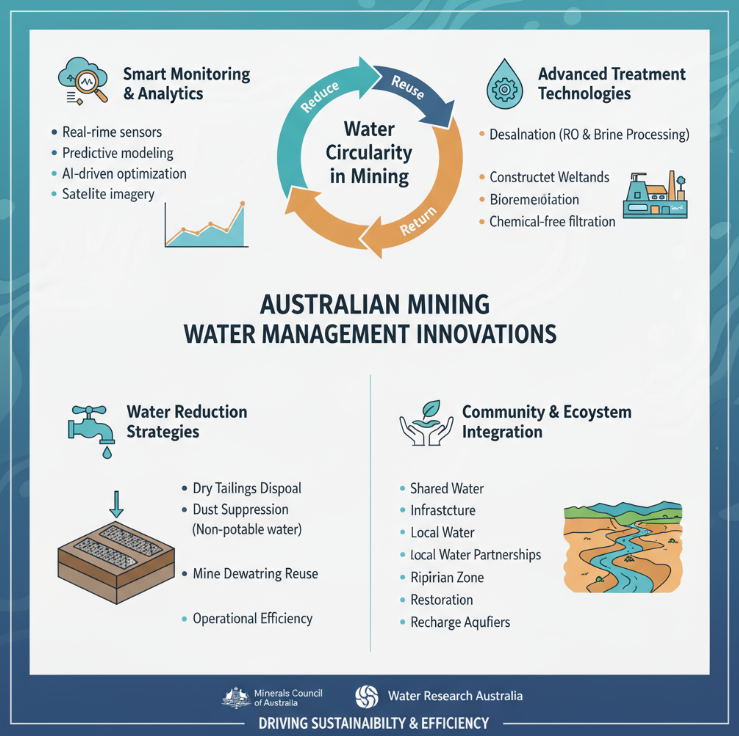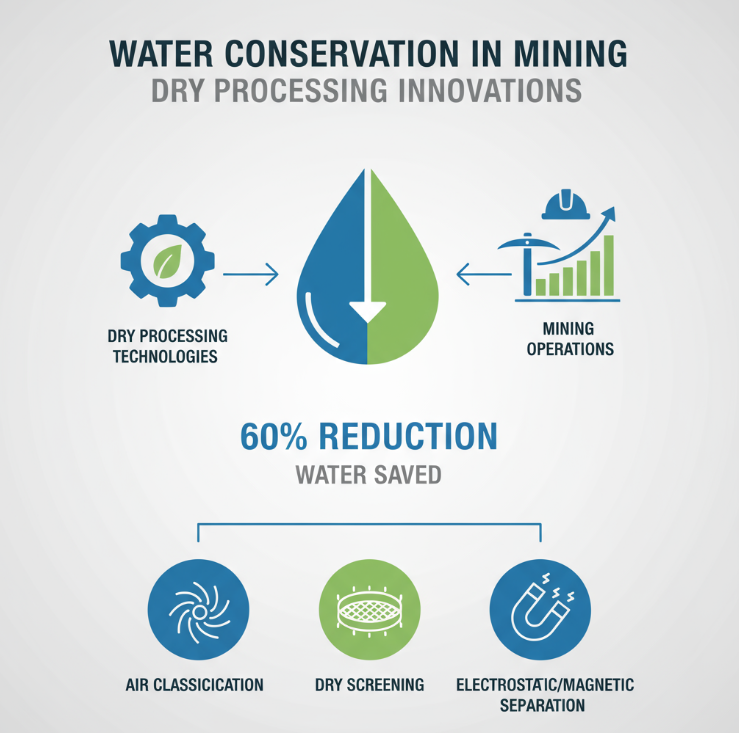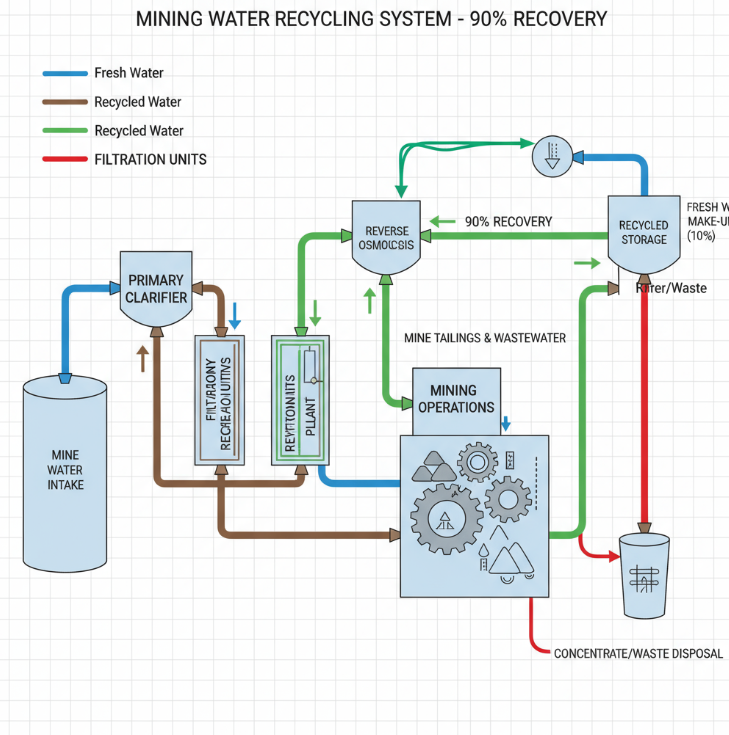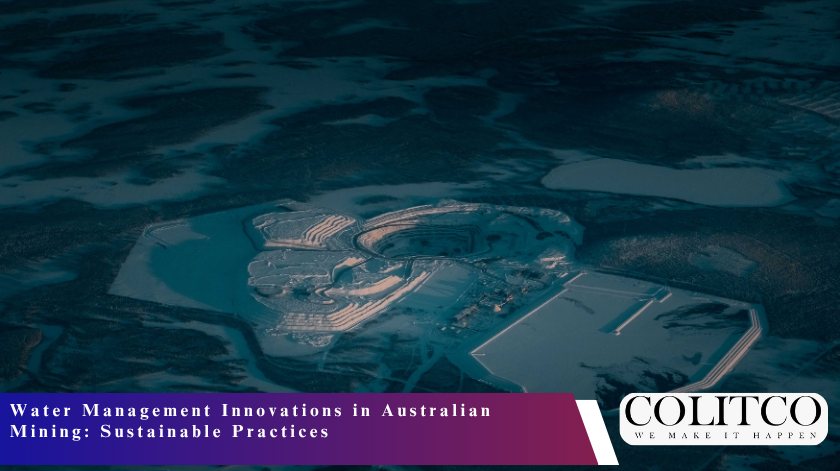Australian mining companies have taken steps to revolutionise water management to ensure sustainability. Recent innovations focus on minimising freshwater usage, recycling process water, and real-time monitoring for efficiency. These advancements reshape how mines operate within environmentally sensitive areas.

Australian mining water management
Dry Processing Technologies Reduce Water Use
Several companies now use dry magnetic separation and air classification techniques. These methods separate minerals without requiring water, cutting consumption by as much as 60 per cent. For example, ResoDry’s vibratory dry separation system achieves an 80 per cent reduction in water use during ore processing, while maintaining high recovery rates. Waterless flotation methods that replace water with ozone or electrostatic forces also contribute to lowering water footprints. Alongside these, dust suppression utilises alternatives like biodegradable polymers instead of water sprays. Such technological shifts reduce reliance on scarce freshwater resources in mining regions.

Dry Processing Innovations in water reduction
Advanced Water Recycling Systems
Water recycling forms the backbone of sustainable practice. Mining operations increasingly deploy closed-loop water circuits that recycle over 90 per cent of process water. Advanced membrane technologies such as reverse osmosis and ultrafiltration remove contaminants effectively, enabling reuse of water to near drinking quality. Freeport-McMoRan reported a 65 per cent cut in freshwater needs after installing membrane bioreactor systems, while also improving water discharge quality. These technologies contribute to regulatory compliance and reduce the environmental impacts of mining activities.

Water recycling system
Real-Time Monitoring for Water Quality
The integration of Internet of Things (IoT) sensors and AI-driven analytics enables continuous water quality monitoring. Mines detect contamination or efficiency lapses early, allowing swift interventions. Wireless sensor networks track water parameters at critical points, optimising water use and pollution control. This ensures operational continuity while protecting surrounding ecosystems. Monitoring groundwater withdrawal rates guards against aquifer depletion, crucial in Australia’s often arid mining zones.
Case Study: Kalgoorlie Super Pit
The Kalgoorlie Super Pit in Western Australia offers a model for sustainable water management. The mine monitors groundwater in real time to ensure extraction does not surpass recharge rates. Treated mine water recycles for dust suppression and site rehabilitation tasks, lowering dependence on external sources. This approach extends the usable life of local water supplies while meeting industry environmental standards.
Desalination and Alternative Sources
In drought-prone regions, some mines use desalinated seawater or treated wastewater, reducing freshwater demand. These supplementary sources support water security and lessen mining impacts on traditional water supplies. Rainwater harvesting also supplements water availability, especially in areas with seasonal rainfall. Together, these strategies help mines operate reliably despite climate variability.
Technologies Maximising Water Recovery
High-efficiency treatments such as advanced reverse osmosis systems improve water recovery rates in processing. High-density sludge treatment reduces the volume and toxicity of mine wastewater by stabilising contaminants. These technologies cut long-term treatment costs and environmental liabilities, contributing to mine sustainability commitments.
Industry Commitment and Regulatory Frameworks
The Australian minerals sector recognises water as a shared resource with environmental, cultural, and economic value. The industry complies with stringent water resource planning, environmental approvals, and national legislation. Organisations like the Minerals Council of Australia lead in transparent water accounting and reporting. Surveys indicate over 80 per cent of mining executives prioritise sustainable water management due to its impact on project success, environmental protection, and community relations. As Vice President Mick Scrivens of Black & Veatch states, “Prioritising stewardship using integrated water solutions will return dividends for the environment, communities, mining companies and the industry.”
Also Read: Australian Mining’s Path to Net-Zero: Strategic Decarbonisation Transforming Industry by 2050
Community Engagement and Cultural Values
Mining companies increasingly engage with local communities and Traditional Owners regarding water management. Transparency in water use and joint monitoring initiatives build social licence to operate. This collaboration respects Indigenous cultural values tied to water and supports long-term resource availability.
Conclusion
Australian mining’s innovative water management initiatives demonstrate a serious commitment to sustainability. Dry processing technology, advanced recycling, real-time monitoring, and alternative water sourcing significantly reduce freshwater consumption. Combined with stringent regulatory compliance and community partnerships, these practices contribute to environmental protection and operational resilience. The industry continues to evolve its water stewardship strategies to meet current and future challenges effectively.












